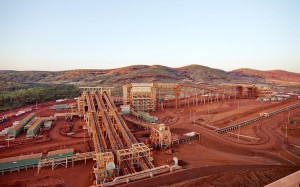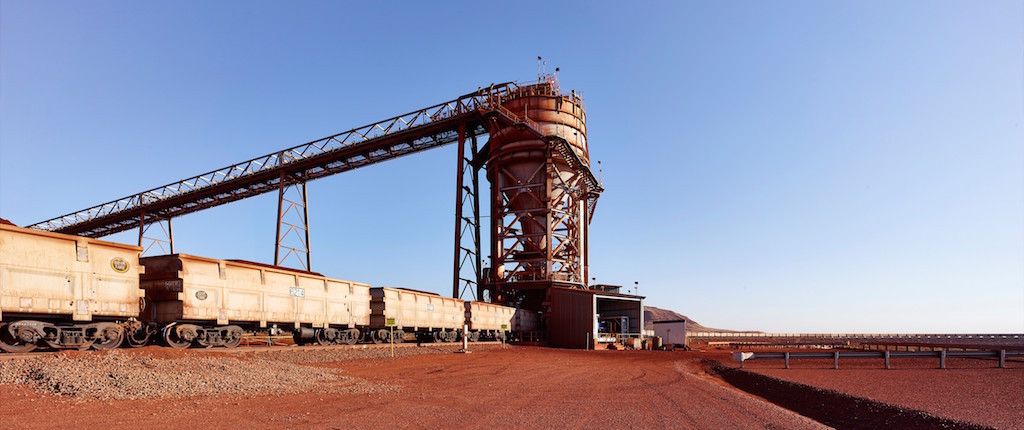Development of Fortescue Metals Group’s (FMG) 60mtpa (Million Tons Per Annum) Solomon Iron Ore Project in Western Australia’s Pilbara was completed in just over two years – including the construction of two new mines, primary and secondary crushers, two ore processing facilities, PROFINET & PROFIBUS control networks, 15km of overland conveyors, rail, and other infrastructure.
 In consultation with project system integrators I&E Systems, the project was split into seven Design & Construct (D&C) packages, appointing a different contractor for each stand-alone package. I&E Systems defined strict operational guidelines to each contractor for the D&C packages, and undertook all the designing, engineering, integrating and implementation of the electrical and control systems, including making the seven D&C packages work together. Each standalone D&C package has its own set of servers and can easily communicate with the others via interface blocks and a control system design based on Fortescue’s preferred vendor GE and their new platform Proficy Process Systems (PPS).
In consultation with project system integrators I&E Systems, the project was split into seven Design & Construct (D&C) packages, appointing a different contractor for each stand-alone package. I&E Systems defined strict operational guidelines to each contractor for the D&C packages, and undertook all the designing, engineering, integrating and implementation of the electrical and control systems, including making the seven D&C packages work together. Each standalone D&C package has its own set of servers and can easily communicate with the others via interface blocks and a control system design based on Fortescue’s preferred vendor GE and their new platform Proficy Process Systems (PPS).
Background
In 2008, Fortescue’s two mines at the Chichester Hub and the Herb Elliott port and rail infrastructure at Port Headland were made operational. PROFIBUS was used as the exclusive fieldbus technology for all electrical and control networks, proving itself to be particularly reliable in rugged environments with extreme temperatures and noise.
In late 2011, Fortescue started early greenfield work at the Solomon Hub, 120km west of the Chichester Hub. It consists of the Firetail and Kings Valley mines. The iron ore is crushed, scrubbed and screened before further ‘fines’ crushing at the ore processing facility. The screened ‘midsize’ and washed, cleaned ‘fines’ combined product is transported via conveyor to the stockyard, from where it is reclaimed for rail transfer to the port and subsequent export.
For PLC-to-remote-I/O communications, the Solomon project would use PROFINET. This future-proofed the installation, and allowed synergy with GE’s capabilities since it had standardized its Proficy Plant Systems (PPS) platform on PROFINET in 2012.
 Choosing PROFINET
Choosing PROFINET
PROFINET’s advantages for the project included:
- Major operational and productivity gains from integrating information and automation systems
- Deployment of thousands of easily-replaceable nodes on a single network, rather than just 126 nodes in PROFIBUS
- Rich network alarm and diagnostic capabilities
- Tapping into the global “Industrial Internet of Things” ecosystem of expertise and replacement items
- Devices identified by application-specific Device Names; each D&C package builder could independently name their devices, while still ensuring consistent node addresses
- PROFINET’s ‘Neighbor Recognition’ feature allows faulty devices to be replaced and automatically configured without specialist tools or knowledge, enabling cost-effective maintenance after handover
In all, the project involved 200 PROFINET scanners and 35 PLCs. I&E Systems also designed and commissioned over 50 GE Cimplicity HMI workstations, and 15 servers. Managing for availability and redundancy would be critical during network planning, but Tom McCarthy (I&E Systems’ Lead Engineer for Fortescue Solomon) stated that PROFINET and GE had pulled through.
Commissioning
 By using a ring topology on each PLC, I&E Systems could easily isolate equipment for increased commissioning and maintenance flexibility. “We commissioned a sample station which had its marshalling panel in the middle of a ring of marshalling panels for a conveyor,” McCarthy explained. “We could power down the marshalling panel, but the conveyor would stay running due to the dual paths of the ring.”
By using a ring topology on each PLC, I&E Systems could easily isolate equipment for increased commissioning and maintenance flexibility. “We commissioned a sample station which had its marshalling panel in the middle of a ring of marshalling panels for a conveyor,” McCarthy explained. “We could power down the marshalling panel, but the conveyor would stay running due to the dual paths of the ring.”
With seven different contractors involved, clear instructions and advanced planning was critical. To maximize interoperability, contractors were required to use I&E System’s DAD Software to design the electrical, control and communication systems for all the D&C packages.
I&E Systems provided the software licenses, training, application support and coordination services to the teams. The digital system design models created via DAD were then installed on a server at the Fortescue headquarters, allowing the commissioning teams to fast-track the project.
To address the potential for poor communications between the different packages, McCarthy said that the team had engineered all the interfaces up front using the PPS language on the GE firmware. “We made sure all the D&C packages lined up beforehand. So when the time came for the final integration, they were engineered in rather than forced into place,” McCarthy explained.
To complete the project, PROFIBUS was selected for inter-PLC control of Solomon’s processing infrastructure. This includes the crushing plants, seven overland conveyors, the Ore Processing Facilities, a wet plant, stockyard, and the train load-out.
Training
Fortescue actively leveraged the support networks provided by the participating companies in training its staff. They took full advantage of available resources to train operators to use the PROFINET systems. They also enrolled engineers in Profibus Australia’s Certified Profibus Installer and Commissioning & Maintenance courses, where they learned about PROFIBUS’s approved commissioning and troubleshooting practices.
